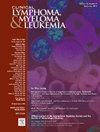异基因造血干细胞移植治疗相关髓系肿瘤的结果:系统回顾和荟萃分析。
IF 2.7
4区 医学
Q2 HEMATOLOGY
引用次数: 0
摘要
治疗相关性髓系肿瘤(t-MN),包括急性髓系白血病(t-AML)、骨髓增生异常综合征(t-MDS)和骨髓增生异常/骨髓增生性肿瘤是继发性恶性肿瘤,作为先前疾病化疗或放疗后的晚期并发症。同种异体造血干细胞移植(alloo - hct)是治疗t-MN患者的潜在治疗选择。本系统综述和荟萃分析旨在探讨同种异体hct治疗t-MN的结果。按照PRISMA的指导方针,在PubMed、Cochrane和Clinicaltrials.gov上进行了全面的文献检索。从Kaplan-Meier曲线中提取生存数据,计算总生存期(OS)和无病生存期(DFS)概率。来自33项原始研究的7785例(t-AML: 67.3%, t-MDS: 26.5%,混合表现:6%)患者报告了t-MN患者的同种异体hct结果被纳入分析。患者年龄2 ~ 89岁,女性占61.7%。合并中位生存期为16.9个月(95% CI: 13.7-21.1),而估计平均生存期为46.0个月(95% CI: 42.1-49.6)。合并中位DFS为8.8个月(95% CI: 7.4-11.2),平均DFS为35.5个月(95% CI: 33.4-41.9)。急性移植物抗宿主病(aGvHD)的合并比例为34% (95% CI: 0.35-0.45, I²:91.71%,P < 0.0001)。髓系肿瘤复发是最常见的死亡原因,其次是感染、基础疾病复发和GvHD。尽管存在这些挑战,对于精心挑选的t-MN患者来说,同种异体hct仍然是一种潜在的治疗选择,具有良好的结果。本文章由计算机程序翻译,如有差异,请以英文原文为准。
Outcomes with Allogeneic Hematopoietic Stem Cell Transplantation in Therapy Related Myeloid Neoplasms: A Systematic Review and Meta-Analysis
Therapy-related myeloid neoplasms (t-MN), which include acute myeloid leukemia (t-AML), myelodysplastic syndrome (t-MDS), and myelodysplastic/myeloproliferative neoplasms are secondary malignancies occurring as a late complication following chemotherapy or radiation therapy for an antecedent disorder. Allogeneic hematopoietic stem cell transplant (allo-HCT) is a potentially curative treatment option in t-MN patients. This systematic review and meta-analysis aimed to explore the outcomes of allo-HCT in t-MN. Following PRISMA guidelines, a comprehensive literature search was performed on PubMed, Cochrane, and Clinicaltrials.gov. Survival data were extracted from Kaplan–Meier curves to calculate overall survival (OS) and disease-free survival (DFS) probabilities. A total of 7785 (t-AML: 67.3%, t-MDS: 26.5%, and mixed presentation: 6%) patients from 33 original studies reporting outcomes of allo-HCT in t-MN patients were included for analysis. The patients age ranged from 2 to 89 years, and 61.7% were female. The pooled median OS was 16.9 months (95% CI: 13.7-21.1), whereas the estimated mean OS was 46.0 months (95% CI: 42.1-49.6). The pooled median DFS was 8.8 months (95% CI: 7.4-11.2), and the mean DFS was 35.5 months (95% CI: 33.4-41.9). The pooled proportion of acute graft-versus-host disease (aGvHD) was 34% (95% CI: 0.35-0.45, I²: 91.71%, P < .0001). Relapse of the myeloid neoplasm was the most common cause of mortality, followed by infections, relapse of the underlying disease, and GvHD. Despite these challenges, allo-HCT remains a potential treatment option with promising outcomes for carefully selected t-MN patients.
求助全文
通过发布文献求助,成功后即可免费获取论文全文。
去求助
来源期刊

Clinical Lymphoma, Myeloma & Leukemia
ONCOLOGY-HEMATOLOGY
CiteScore
2.70
自引率
3.70%
发文量
1606
审稿时长
26 days
期刊介绍:
Clinical Lymphoma, Myeloma & Leukemia is a peer-reviewed monthly journal that publishes original articles describing various aspects of clinical and translational research of lymphoma, myeloma and leukemia. Clinical Lymphoma, Myeloma & Leukemia is devoted to articles on detection, diagnosis, prevention, and treatment of lymphoma, myeloma, leukemia and related disorders including macroglobulinemia, amyloidosis, and plasma-cell dyscrasias. The main emphasis is on recent scientific developments in all areas related to lymphoma, myeloma and leukemia. Specific areas of interest include clinical research and mechanistic approaches; drug sensitivity and resistance; gene and antisense therapy; pathology, markers, and prognostic indicators; chemoprevention strategies; multimodality therapy; and integration of various approaches.
 求助内容:
求助内容: 应助结果提醒方式:
应助结果提醒方式:


